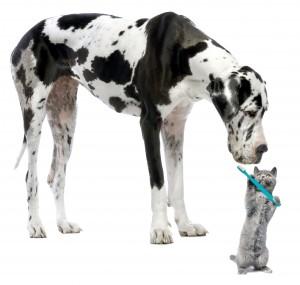When it comes to taking care of their pets, most owners think about vaccination, diet, and exercise. Most, underestimate the importance of dental care. Shockingly, 4 out of 5 dogs and cats over the age of three develop periodontal disease.
Like us, every time your pet eats, food particles adhere to their teeth – and where there’s food, there’s bacteria. If not adequately removed, saliva and bacteria combine to form plaque. This plaque then calcifies and hardens into tartar, which provides a safe haven for bacteria to multiply. The accumulation of bacteria laden plaque and tartar will lead to oral health issues, most commonly, periodontal disease. Our pets are also at risk for broken teeth, orthodontic problems, and even cavities. All of these issues can affect our pet’s oral health, obviously, but studies have shown that there is a correlation between oral health issues and systemic general health issues affecting the kidneys, heart, and metabolic systems. In other words, bad breath and tartar can lead to a sick pet.
Now you may be asking yourself is there anything we can be doing to prevent and reverse dental disease? Absolutely! It all starts with preventative dental care. Here are some tips on how to practice good dental care that will extend your pets life.
The best thing we can do for our pets teeth is brush them, and I mean daily. We don’t brush our teeth once a week or once a month. The same principles apply to our pets. I know this isn’t for most owners, I’m one of them. For those select few of you who are willing to brush your pet’s teeth I commend you.
AHAA, the American Animal Hospital Association , has put together an informative article on how to brush your pet’s teeth. Below is a condensed version of their 5 step approach.
To clean the inside surfaces of your pet’s teeth:
1. Place your hand over your pet’s muzzle from the top
2. Gently squeeze and push their lips on one side between the back teeth
3. Pull their head back gently so their mouth opens
4. Brush their teeth on the opposite side
5. Repeat this process for the other side
Daily brushing of your pet’s teeth is the gold standard for preventative dental care but there are other alternatives that can help. When we brush our teeth it’s not the toothpaste that is doing the majority of the work, but rather the mechanical action of the toothbrush. There are now diets on the market that leverage this knowledge and that have been designed to simulate the action of toothbrushes. Most kibbles out there are small and brittle. So when, or in some cases if, our pets chew their kibble it crumbles apart and does nothing for their teeth. Dental diets are formulated so that their teeth sink into the kibble which in turn scrub them clean.
In addition to dental diets there are now dental treats. Some work on the same principles as dental diets whereas others have enzymes in them to help dissolve plaque. There is a plethora of options on the market and finding the right ones can be daunting. A helpful guideline is to look for foods and treats with a specific seal of approval from the VOHC – the Veterinary Oral Health Council. Products with their seal of approval have undergone additional testing to prove that they help retard plaque and tartar buildup.
Daily oral care is vital but doesn’t replace the need for routine dental exams and cleanings by your veterinarian. Dental exams should be a routine part of your pet’s physical exams. They can help identify dental disease early, and appropriate treatment plans can be discussed.
With proper daily oral care, routine veterinary exams, and a healthy diet, you will make a positive difference in the overall health of your pets.
To promote dental care, during the month of February & March, our technicians are available for a free dental exam and tooth cleaning demonstrations . Furthermore, we our offering a 15% discount on all dental cleaning.
